MICROSCOPIC
FRAGMENTS OF MESOZOIC CONIFER WOOD FOUND IN THE KIMMERIDGE CLAY
AND PURBECK SEDIMENTS AND RELATED TOPICS.
BY
KEITH W. ABINERI, UK.
42
West Borough, Wimborne, Dorset BH21 1NQ, UK
Tel. 01202 885547
Introduction.
During the latter parts of the Jurassic Period, i.e. in
Kimmeridgian, Portlandian and Purbeckian times, the North
Atlantic was beginning to open up between North America and
Europe. In Kimmeridgian times this appears to have resulted in
the accumulation of large quantities of land swamp vegetation in
the Kimmeridge marine deposits. This seems to have occurred under
fluctuating conditions due to sea level changes, or changes in
the land rainfall and levels of the water-tables. This suggests
low lying forest land on both continental areas. The decaying
vegetation could take the form of Kerogen, a variety of plant
products, including pollen and plant spores, and fragments of
wood fusain and pyrites. These would be deposited on a shallow
sea floor together with marine nannofossils and microfossils in
enormous numbers. Periodic anaerobic conditions would occur,
either by virtue of the allochthonous1 decaying land
organic material, or the periodic occurrence of marine algal
"blooms" from the abundance of nannofossils or
microfossils, or effects from both processes.
It is possible that the earliest phases in the splitting of
Laurussia (the Canadian shield, North Europe, Scandinavia and
European Russia) occurred at the beginning of the Triassic
Period. During the Jurassic Period the North Atlantic seems to
have expanded from a narrow sea channel to more open seas in the
Cretaceous Period. This process of ocean floor spreading
continued throughout the Tertiary and Quaternary Periods until
the present time. It is believed now that equally momentous
changes in the climate, environment and forms of life took place
on this vast time scale. Today we are obliged to consider other
massive influences on the evolution of life, which have occurred
throughout geological time. These could have included enormous
volcanic activity, impacts by meteorites, asteroids or comets and
mass extinctions of many different species. Of course the global
volcanic processes would be related to plate tectonics or mantle
"hot spot" activity.
Here we are concerned with more gradual changes in the geological
and biological environments, which can be studied under the
microscope, from the fine structure of sediments. This refers
especially to minute fragments of Mesozoic conifer wood found in
the Kimmeridge Clay and Purbeck beds, as well as related
features.
In l983 Dr Jane E. Francis published a very valuable and
informative paper on the Lower Purbeck (Upper Jurassic) Fossil
Forest of Dorset. The title of this paper was "The Dominant
Conifer of the Jurassic Purbeck Formation, England."2
Dr Francis identified this dominant conifer tree, for the first
time, as the species Protocupressinoxylon purbeckensis3.
Full information was given on the shape, size and structure of
these trees, the fine structure of the wood and the
characteristics of the pollen. Remains were found in the form of
fusain and silicified wood. Perhaps most interesting to what
follows here were the minute structures of the tracheid
"bordered pits"4, which were typical of
these conifer trees. These were first found by the present author
below the Purbeck beds in the Kimmeridge Clay using the cellulose
lacquer technique during l987. Dr Francis confirmed that these
"bordered pit" conifer wood structures from the
Kimmeridge Clay beds showed similarity to those for Protocupressinoxylon
purbeckensis, which had been studied by her in the Purbeck
beds. Later these microscopic structures were found on cellulose
lacquer peels from the Lower Purbeck.
A further very interesting paper on the Mesozoic conifers was
published by Dr J. E. Francis in l984, under the title "The
Seasonal Environment of the Purbeck (Upper Jurassic) Fossil
Forests."5
Furthermore, since the Kimmeridge Clay is believed to be
the source rock for North Sea petroleum, there appears to be an
analogy with the much more ancient formation of coal from the
great fern forests of the Carboniferous Period. The Kerogen from
the Mesozoic forest swamps of the Jurassic Period, under the
action of heat and pressure would form liquid petroleum. From the
following illustrations (Figures (1) to (6),) it would seem that
many of these forest trees were Mesozoic conifers.
"Bordered Pit" Tracheid
structures from the Kimmeridge Clay and Purbeck Sediments i.e.
Figures (1) to (4).
| Figure (1).
Fragments of Mesozoic conifer wood with damaged bordered
pit structures from the Jurassic, Kimmeridge Clay, Maple
Ledge Shales. Map Reference : SY.908.790. East of Gaulter
Gap, Kimmeridge Bay, Dorset coast. Oil-immersion
objective N.A. = 1.25. Total field area of the image =
circa 105 microns X 80 microns. |
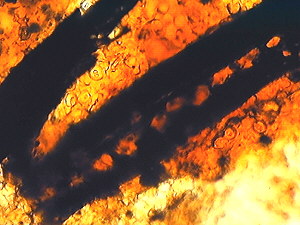 |
Figure (1) shows also unstained coccoliths embedded in kerogen
and is mainly a removed thin layer type of image. The fusain has
been peeled from the rock with the kerogen. It is part of a
stained cellulose lacquer rock peel. Many lacquer peels were
prepared from the shales in this location and, on average, 50 to
100 minute wood fragments were found on 1 cm² of each peel. In
areas very rich in coccolithic limestone the numbers of wood
fragments was much lower.
Figure (1) was obtained with brightfield illumination.
| Figure (2).
Here we have a relatively intact but isolated bordered
pit structure from a Mesozoic conifer tree. This minute
object was found again on a stained peel from the
Jurassic, Kimmeridge Clay, Maple Ledge Shales. Map
Reference : SY.908.790. East of Gaulter Gap, Kimmeridge
Bay, Dorset coast. Oil-immersion objective N.A. = 1.25.
Total field area of the image = circa 90 microns X 60
microns. |
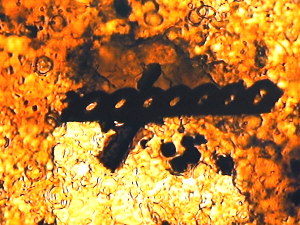 |
Figure (2) shows also unstained coccoliths embedded in kerogen
and is mainly a removed thin layer type of image. The fusain ring
components have been peeled from the rock with the kerogen. The
maximum outer diameter of these rings averages circa 13 microns.
Figure (2) was obtained with brightfield illumination.
| Figure (3).
A further relatively intact but isolated bordered pit
tracheid structure from a conifer tree, comparable with
Protocupressinoxylon purbeckensis, was found on a stained
peel, from the Jurassic, Kimmeridge Clay, White Stone
Band, Dark Shale Layer Map Reference SY.936.776. West of
Freshwater Steps, Dorset coast. Oil-immersion objective
N.A. = 1.25. Total field area of the image = circa 60
microns X 45 microns. |
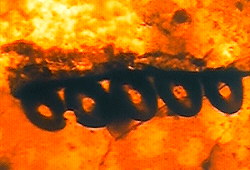 |
Figure (3) shows once more unstained coccoliths embedded in the
kerogen layer. These objects are golden yellow in appearance and
generally not focussed because of the thickness of the kerogen
layer, and the small depth of focus with the oil-immersion
objective. This cellulose lacquer peel is clearly a removed thin
layer type, the kerogen, various minute pieces of fusain and
coccoliths having been stripped from the rock surface. Numbers of
other minute wood fragments were found on this single 1 cm²
peel, some of which showed damaged bordered pit tracheid
structures.
Throughout the Kimmeridge Clay sediments, bordered pit structures
similar to those associated with Mesozoic Conifer Protocupressinoxylon
purbeckensis have been found on cellulose lacquer peels. The
numbers vary considerably, and the darker shale layers contain
the most examples.
Figure (3) was obtained with brightfield illumination. The
maximum outer diameters of the fusain rings on Figure (3) are
circa from 14 to 15 microns.
| Figure (4).
This picture of a conifer bordered pit tracheid structure
was derived from the Jurassic, Lower Purbeck, Cypris
Freestones, Micrite and Clay Layer. Map Reference :
SY.972.785. Swanworth Quarry6, West
of Swanage, Dorset coast. Oil-immersion objective N.A. =
1.25. Total field area on the image = circa 120 microns X
85 microns. |
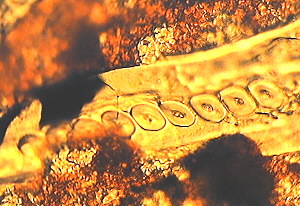 |
A large part of the bordered pit structure here is a replica
image, but the red stained micrite is a removed layer of rock
material. A small layer of fusain has also been removed from the
rock surface. Small broken coccoliths in the micrite may be due
to a lagoon environment, which was believed to exist in Purbeck
times. The maximum outer diameters of the pits on Figure (4) are
circa from 15 to 16 microns. The size and shape of these minute
features agree with the original findings of Dr J.E. Francis.
Figure (4) was obtained with brightfield illumination used on the
stained cellulose lacquer peel and shows an obvious advantage of
some replica images.
Protective Resin (Amber) associated with the Purbeck
Mesozoic Conifers.
| Figure (5).
A microscopic flake of resin peeled from a minute wood
fragment derived from the Jurassic, Lower Purbeck, Cypris
Freestones, Micrite Ostracod bed. Map Reference :
SY.972.785. Swanworth Quarry, West of Swanage, Dorset
coast. Oil-immersion objective N.A. = 1.25. Total field
area of the image = circa 90 microns X 65 microns. |
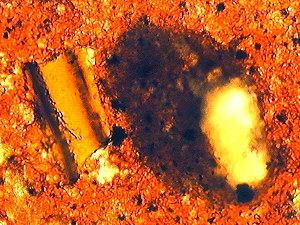 |
The background of Figure (5) consists of red stained micrite,
unstained silica grains and some small particles of pyrites or
fusain. There are also some small damaged coccoliths suggesting a
lagoon environment. The size of the resin flake is about 18.5
microns X 37 microns. Numbers of similar resin flakes have been
found in these Purbeck sediments, derived from coated wood
fragments. It is assumed that this resin (amber7) was
extruded by the conifer wood for protection against insect
attack. (See also Figure (6).). This predatory activity would
have been especially severe at a time before the emergence of
flowering plants at the later part of the Cretaceous Period.8
Figure (5) was obtained with brightfield illumination used on a
stained cellulose lacquer peel.
A Mesozoic Conifer Resin Duct.9
| Figure (6).
A longitudinal section of a Mesozoic Conifer Resin Duct
from the Jurassic, Lower Purbeck, Cypris Freestones,
Micrite Insect bed, Map Reference : SY.972.785. Swanworth
Quarry, West of Swanage, Dorset coast. Oil-immersion
objective N.A. = 1.25. Total field area of the image =
circa 115 microns X 60 microns. |
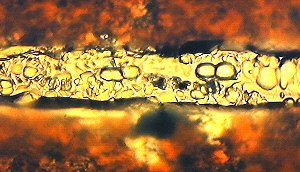 |
The main image in Figure (6) is a replica type, which shows the
longitudinal section of the duct, with globules of resin, in a
complex tube type structure. A similar image of a conifer resin
duct, also with the appearance of a replica image, had been found
previously on an unstained peel from the Kimmeridge Clay, Rope
Lake Head Stone band. Map Reference SY.926.775. To have found
these two minute longitudinal sections both showing the resin
globules was a lucky chance, and tended to confirm the predatory
activity of insects towards these ancient conifers. Furthermore
many insect fossils have been found in the Purbeck Micrite beds.
The resin globules shown on Figure (6) have linear dimensions
which vary from < 2 microns to about 13 microns. Figure (6)
was derived from a stained cellulose lacquer rock peel using
brightfield illumination with one polarizing plate above the
objective. The resin flakes found in the Purbeck beds were far
too small to contain complete insects, similar to those found in
the "Baltic Amber" from the Tertiary10.
Likewise in the Kimmeridge Clay beds it has not been possible to
determine the proportion of kerogen which might have been derived
from amber resin.
Notes and References.
1. Allochthonous : The term applied to the material forming
sediments which have been transported to the site of deposition.
2. Dr Jane E. Francis 1983. "The Dominant Conifer of the
Jurassic Purbeck Formation, England." Palaeontology, Vol.
26, part 2, 1983, pp. 277-294, pls. 38-41. This is a very
valuable and informative paper on the Lower Purbeck Fossil
Forests of Dorset and gives a full account of the dominant
conifer tree, including the shape, size, structure, the fine
structure of the wood and the form of the Classopollis conifer
pollen.
3. Protocupressinoxylon purbeckensis : Systematic
species name by Dr J. E. Francis l983 for the dominant Mesozoic
conifer.
4. Bordered Pit tracheid structures : These characteristic
microscopic features were found among the wood fusain fragments
in the Kimmeridge Clay and the Purbeck beds on cellulose lacquer
rock peels. These were a strong indication of similar Mesozoic
conifer trees. Often the minute structures were damaged or
completely separated as individual fusain rings. They are pits in
the walls of the elongated xylem tracheid cells adapted for
conduction of water, as part of the transpiration mechanism. The
shape, size and arrangement of the pits vary with different
species of Mesozoic conifers. The pits can be separated from
other organic residues by Palynology techniques.
5. Dr J. E. Francis 1984. "The Seasonal Environment of the
Purbeck (Upper Jurassic) Fossil Forests.". Palaeogeography;
Palaeoclimatology; Palaeoecology; 48 (1984); 285-307. Elsevier
Science Publishers B.V. Amsterdam. Here Dr J.E. Francis discusses
the association of evaporites and fossil forest vegetation,
representing well developed gymnosperm forests, which grew on the
borders of the shallow, hypersaline Purbeck lagoon which covered
southern England during the late Jurassic. The trees were adapted
to growing in a semi-arid environment, which approximated to a
Mediterranean type of climate, with warm wet winters when the
trees were able to grow but with hot, arid summers suitable for
the formation of evaporites. Dr J. E. Francis is a very
experienced research scientist in the area of fossil forests and
past climates. She has worked extensively for the British
Antarctic Geological Survey and in the far North of Canada and
elsewhere.
6. In the late 1980's it was reported that fossil insects had
been seen in the Cypris Freestone beds being cleared from above
the Portland Stone being quarried at Swanworth. Local amateur
geologists were invited to examine some of these freshly exposed
beds, through the Dorset Open University Geological Society
Group, in co-operation with Dorchester Museum. Numbers of insect
fossils were found, but the present author found also many small
fragments of wood. Figures (4),(5) and (6) are based on peels
prepared at this time.
7. Amber : This fossil resin was extruded by conifer trees to
protect them from vigorous attack by insects. Well-known examples
of complete fossil insects and other related arthropods have been
found embedded in pieces of Tertiary amber. In 1988 a Cretaceous
bee was found in amber from New Jersey.
8. Insects had existed on land at least 320 million years ago in
the Carboniferous fern forests, but in the late Cretaceous period
insect evolution accelerated because of the emergence of
flowering plants. Nectar became an important food and gave rise
to "symbiosis " between flowering plants and insects.
This appears to have led to the emergence of advanced social
insects (ants, bees etc).
9. These appear to be similar to contemporary conifer resin
ducts. Some amber has been found in the Lower Purbeck beds using
Palynology techniques. Although it is suspected that some of the
transparent kerogen in the Kimmeridge Clay may be derived from
amber, this is difficult to prove.
10. A Special note on Fossil Insects.
Some of the best examples of fossil insects have been
investigated by Dr Ed Jarzembowski of the Booth Museum of Natural
History, Brighton, Sussex, UK. These are mainly from the Wealden
in southern England, where they are embedded in siltstone beds.
The quality of preservation is outstanding and they include a
large variety of species.
Editor's notes: Some of the
quality of the author's original 35mm slides is lost in the
scanned and compressed web images. Comments to the author are
welcomed, who can be contacted at the above address or comments
can be passed on via the Micscape Editor, see contact on magazine
index.
The previous three articles in this series can
be accessed in the Micscape on-line library by typing in the
author's surname 'Abineri' in the Library search engine (link
below).
Prepared for the Web by David Walker
© Microscopy UK or their
contributors.
Published in the May 1999
edition of Micscape Magazine.
Article at
http://www.microscopy-uk.net/mag/artmay99/kamast4.html
Please report any Web problems
or offer general comments to the Micscape Editor,
via the contact on current Micscape Index.
Micscape is the on-line monthly
magazine of the Microscopy UK web
site at Microscopy-UK
WIDTH=1
© Onview.net Ltd, Microscopy-UK, and all contributors 1995 onwards. All rights
reserved. Main site is at www.microscopy-uk.org.uk with full mirror at www.microscopy-uk.net.





